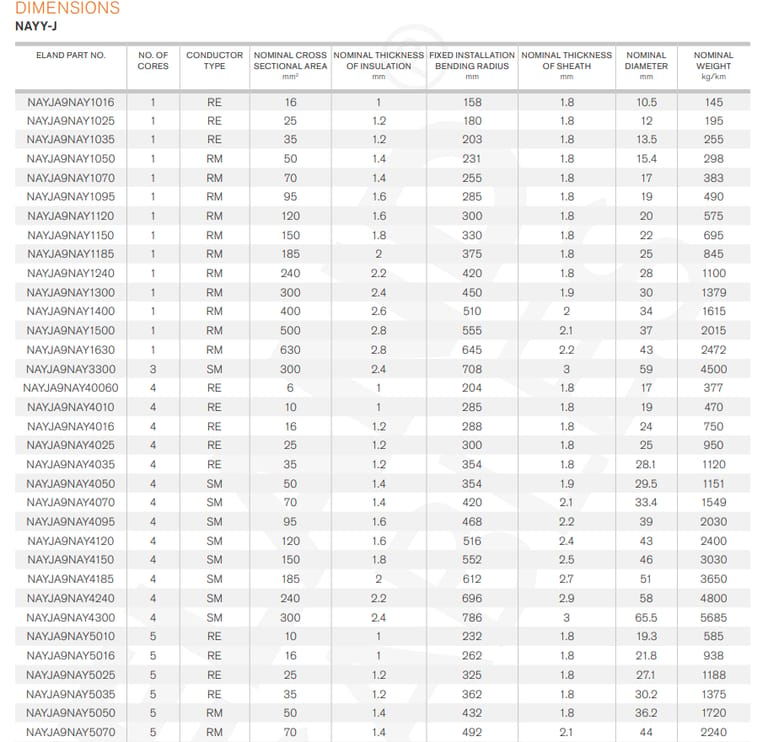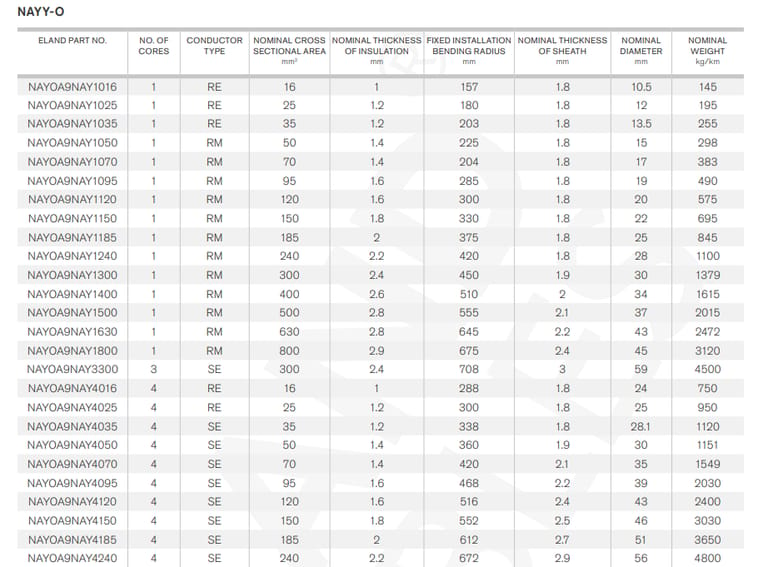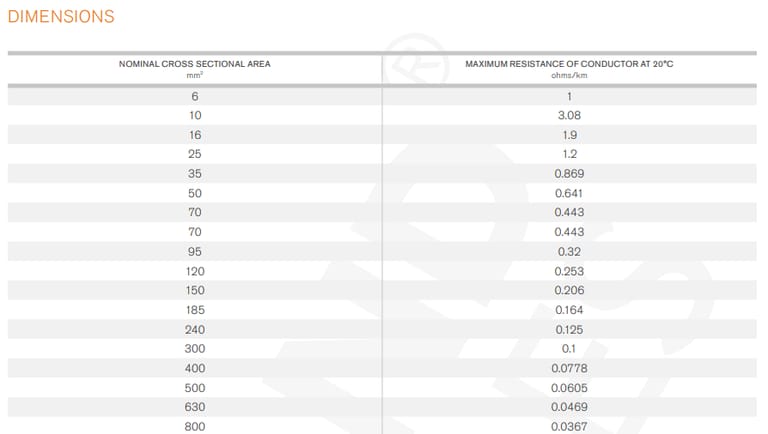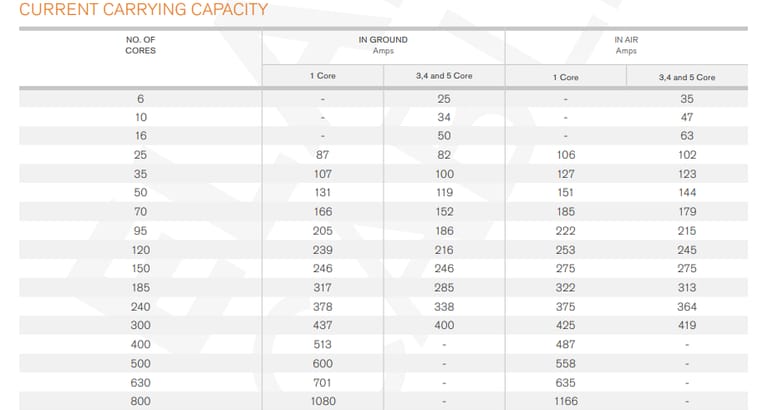Anhui Feichun Special Cable Co.,Ltd Li.wang@feichuncables.com

NAYY-J / NAYY-O Cable Aluminium Conductor PVC PVC 0.6/1kV Cable
Category | Details |
|---|---|
Application | For fixed installation in buildings, in free air, in ground, and in water. |
Characteristics | |
Voltage Rating Uo/U | 0.6/1kV |
Operating Temperature | -5°C to +70°C |
Construction | |
Conductor | - RE: Class 1 solid aluminium-circular or circular compacted |
- RM: Class 2 stranded | |
- SM: Class 2 sector-shaped | |
- SE: Class 1 solid sector-shaped or stranded (available upon request) | |
Insulation | PVC (Polyvinyl Chloride) |
Sheath | PVC (Polyvinyl Chloride) |
Core Identification | |
NAYY-J | - 1 core: Green/Yellow |
- 3 core: Green/Yellow, Blue, Brown | |
- 4 core: Green/Yellow, Brown, Black, Grey | |
- 5 core: Green/Yellow, Blue, Brown, Black, Grey | |
- 7 core and above: Black with White numbers | |
NAYY-O | - 1 core: Black |
- 3 core: Black, Brown, Grey | |
- 4 core: Blue, Brown, Black, Grey | |
- 5 core: Blue, Brown, Black, Grey, Black | |
- 7 core and above: Black with White numbers | |
Sheath Colour | Black |
Standards | IEC 60502-1, VDE 0276-603, HD 603, IEC 60228 |
Flame retardant according to IEC/EN 60332-1-2 |





The Anatomy of Reliability: Construction of NAYY-J and NAYY-O Cables
At their core—quite literally—the NAYY-J and NAYY-O cables are engineered for longevity in harsh environments, making them ideal for South Africa's diverse terrains, from the arid Karoo to the humid KwaZulu-Natal lowlands. These low-voltage power cables, rated at 0.6/1kV (Uo/U), feature an aluminium conductor sheathed in dual layers of polyvinyl chloride (PVC), a thermoplastic renowned for its flexibility and resistance to abrasion.
The conductor forms the backbone, available in multiple configurations to suit installation demands:
RE (Class 1 solid aluminium—circular or circular compacted): A seamless, solid rod perfect for straight runs where minimal joints are preferred, reducing resistance and heat buildup.
RM (Class 2 stranded): Flexible twisted strands that excel in bends and pulls, common in conduit-fed building wiring.
SM (Class 2 sector-shaped): Optimised for space-saving in multi-core cables, minimising overall diameter without sacrificing current-carrying capacity.
SE (Class 1 solid sector-shaped or stranded—available on request): Tailored for high-density applications like switchboards.
This aluminium choice isn't arbitrary. Lighter and more abundant than copper, it slashes material costs by up to 50% while maintaining excellent conductivity—crucial in a country where Eskom's transmission losses already strain budgets. Encasing the conductor is the primary PVC insulation, a compound that withstands voltages up to 1kV and operating temperatures from -5°C to +70°C, shrugging off the chill of Highveld winters or the scorch of summer highs.
The outer PVC sheath adds a fortress-like barrier: black for UV resistance in outdoor exposures, it's extruded uniformly to prevent moisture ingress. Flame retardancy per IEC/EN 60332-1-2 ensures it doesn't propagate fires, a non-negotiable in fire-prone urban settings. Core identification varies by variant, enhancing safety during maintenance:
For NAYY-J (with earth core):
1 core: Green/Yellow (earth).
3 cores: Green/Yellow, Blue, Brown.
4 cores: Green/Yellow, Brown, Black, Grey.
5 cores: Green/Yellow, Blue, Brown, Black, Grey.
7+ cores: Black with white numbers.
For NAYY-O (without earth core):
1 core: Black.
3 cores: Black, Brown, Grey.
4 cores: Blue, Brown, Black, Grey.
5 cores: Blue, Brown, Black, Grey, Black.
7+ cores: Black with white numbers.
This colour-coding aligns with VDE 0276-603 and HD 603 standards, preventing mix-ups in multi-phase systems—a small detail that averts costly downtime in industrial setups.
Applications: From Urban Sprawl to Subterranean Depths
Versatility defines the NAYY-J and NAYY-O cables, certified for fixed installations in buildings, free air, ground, and even water. In South Africa, where infrastructure backlogs meet rapid urbanisation, this adaptability shines. Indoors, they're threaded through walls and ceilings for lighting and power circuits, their PVC sheath guarding against rodent nibbles in older structures. In free air, suspended on poles or trays, they power temporary sites like construction camps, enduring wind and dust.
Buried directly in soil (without additional protection, per standards), they suit rural electrification drives, transmitting up to 1kV without armoured vulnerability to corrosion. Submerged applications? Think harbour expansions in Durban or Cape Town's coastal renewables—their watertight PVC extrusion repels ingress, maintaining integrity in saline environments.
Consider the 2025 grid crunch headlines: Eskom's July invitation for private pre-qualification in transmission expansions highlights the need for scalable cabling. Here, NAYY cables step in as the economical backbone, linking new substations to homes without the premium price of XLPE alternatives. Their -5°C low-temp rating ensures reliability during blackouts-turned-cold snaps, a boon as the nation eyes 19GW of added renewable capacity by decade's end.
Advantages in a High-Stakes Landscape: Why Aluminium PVC Matters Now
Beyond specs, these cables offer strategic edges in South Africa's volatile energy theatre. Aluminium's lower density (one-third of copper) eases handling, cutting labour costs in labour-intensive installs—a godsend amid skills shortages flagged in recent Infrastructure News reports. PVC's recyclability supports the circular economy push, with waste-to-energy reforms touted by Minister Gwede Mantashe in September 2025 as job creators.
Electrically, the 0.6/1kV rating handles low-voltage distribution efficiently, with low capacitance minimising losses in long runs—vital for Eskom's aging grid, where reactive power surges exacerbate load shedding. Flame retardancy isn't fluff; in a country scarred by informal settlement fires, it complies with SANS 10142-1 wiring regs, potentially saving lives.
Yet, it's the economic calculus that seals the deal. With copper prices volatile amid global supply chains, aluminium's stability—bolstered by local bauxite processing—shields projects from inflation. A 2025 Ecofin Agency analysis pegs solar additions at 23GW continent-wide by 2028; NAYY cables, at R10–R20 per metre for multi-cores, democratise these builds for SMEs.
Drawbacks? Aluminium's higher thermal expansion demands careful terminations to avoid loose connections, but proper crimping per IEC 60228 mitigates this. Compared to rubber-insulated relics, PVC's longevity (25+ years) slashes replacement cycles, aligning with the government's 2025 Electricity Regulation Amendment Act, which mandates resilient networks for wheeling and private generation.

Email Address: Li.wang@feichuncables.com
© 2025. All rights reserved.


One-click to Quickly Contact
Products
Offshore & Marine Cable
XLPE Cable
Contact
Company
Location:
Building A Private Science and Technology Park, Hefei Economic and Technological Development Zone, Anhui Province, China
